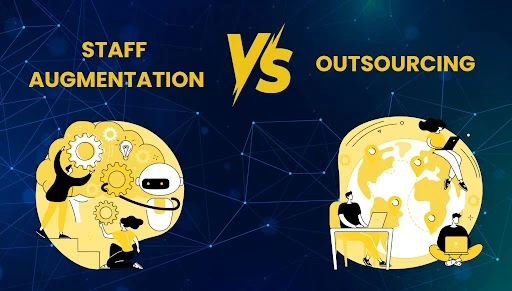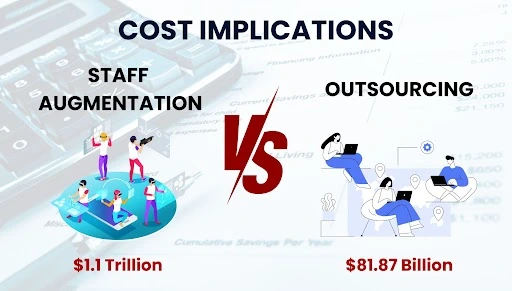
By 2025, we’ll spend about US$81.87 billion on staff augmentation and US$1.1 trillion on outsourcing. These numbers show how much businesses want flexible and affordable work options. Choosing between staff augmentation and outsourcing is key for companies. It depends on what they need now and what they want for the future.
Staff augmentation means hiring temporary workers to help your team. It’s good for filling gaps, handling busy times, or short projects. Outsourcing, on the other hand, means giving certain tasks to outside companies. This lets your team focus on what they do best.
Deciding between these options needs careful thought. You must consider costs, control, flexibility, quality, and the challenges each brings. Knowing these details helps companies make choices that fit their goals and needs.
Table of Contents
Key Takeaways
- Global spending on staff augmentation and outsourcing is expected to grow significantly by 2025.
- Staff augmentation allows for rapid recruitment and onboarding of temporary staff, while outsourcing enables organizations to focus on core business activities.
- The cost implications of staff augmentation and outsourcing vary, with each providing unique savings and access to specialized skills.
- Control and management differ between staff augmentation and outsourcing, with staff augmentation giving more oversight and outsourcing more flexibility.
- Both staff augmentation and outsourcing have their own challenges, including cultural barriers, quality control, and security concerns.
What is Staff Augmentation?
Staff augmentation is a way for companies to grow their teams by hiring contract workers. It lets businesses adjust their team size as needed. This way, they can get the skills they need without keeping those workers long-term.
This method is great for companies that want to control their team. It helps them meet project needs with the right people.
Definition and Key Characteristics
Staff augmentation means adding outside talent to a company’s team for a short time. It lets companies keep control while getting the skills they need. This way, teams can grow or shrink as projects change.
Advantages of Staff Augmentation
- Flexible staffing: Companies can quickly change their team size as projects need.
- Cost-effectiveness: It’s cheaper than outsourcing, which can cost up to 30% more.
- Access to specialized skills: It lets companies get the talents they need without keeping them.
- Rapid project deployment: It helps projects start faster by quickly adding the right team members.
Staff augmentation is a smart choice for businesses. It’s flexible and cost-effective. It helps companies grow their teams without the hassle of keeping everyone long-term.
What is Outsourcing?
Outsourcing is when a company hires others to do certain jobs. This lets them focus on what they do best. It means giving some tasks to experts outside the company.
Definition and Key Characteristics
Outsourcing means hiring others for tasks you can’t do yourself. It saves money on things like software and training. This way, you can focus on your main goals.
The deal with the outside company is based on trust. This helps both sides work well together.
Advantages of Outsourcing
Outsourcing brings many benefits. It lets you use experts for certain jobs. This way, you can do what you’re best at while others handle the rest.
It also means you can find the best people from all over the world. And, you can grow or shrink your team as needed.
Many IT companies use outsourcing to focus on what they do best. They let others handle extra work. This mix of methods is called the hybrid approach.
| Benefit | Description |
|---|---|
| Expertise and Specialization | Outsourcing lets you use skills you might not have in-house. |
| Focus on Core Competencies | Outsourcing helps you focus on your main business by handling other tasks. |
| Access to Global Talent | It lets you find the best people from all over the world. |
| Scalability | It makes it easy to grow or shrink your team as needed. |
Outsourcing makes your business more efficient. It lets you focus on what’s important. The IT world has spent 288 billion dollars on it.
Staff Augmentation vs Outsourcing: The Major Differences
Organizations often choose between staff augmentation and outsourcing for staffing solutions. Each has its own benefits and challenges. Knowing the differences helps businesses make better choices.
Cost is a big difference. Staff augmentation means hiring temporary staff, with costs tied to their pay and a markup. Outsourcing can save money, but managing the external provider adds extra costs.
Control and management are also key. With staff augmentation, you have direct control over the staff. Outsourcing means giving control to the provider, which might limit your management.
Flexibility and scalability matter, too. Staff augmentation allows you to easily adjust your workforce, while outsourcing might be less flexible because of fixed contracts.
| Aspect | Staff Augmentation | Outsourcing |
|---|---|---|
| Cost Implications | Costs associated with staff salaries and a markup | Potential for significant cost savings, but may involve additional expenses for managing the external provider |
| Control and Management | Direct control and oversight of the augmented staff | Handing over control to the external service provider |
| Flexibility and Scalability | Greater flexibility to scale the workforce as needed | May have limitations in terms of flexibility due to fixed contract terms |
The choice between staff augmentation and outsourcing depends on your organization’s needs. Understanding these differences helps make informed decisions that fit your goals and operations.
Cost Implications: Staff Augmentation vs Outsourcing

Staff augmentation and outsourcing have different costs. Staff augmentation costs include the salary of the staff and a markup from the agency. It’s good for short-term projects because it doesn’t have the costs of hiring full-time employees.
Outsourcing can save a lot of money, mainly when tasks go to places with lower labor costs. But, you also have to think about managing the work, quality control, and risks of using an outside provider.
| Metric | Staff Augmentation | Outsourcing |
|---|---|---|
| Cost-effectiveness | Suitable for short-term projects | Significant cost savings, mainly with lower labor costs |
| Long-term Expenses | Avoids the long-term costs of hiring full-time employees | Must account for management, quality control, and other risks |
| Flexibility | Allows for flexible resource allocation and scaling | Offers fixed project costs through negotiated contracts |
| Risk | Lower risk as the in-house team retains control | Higher risks as they depend on the performance of the external entity |
The choice between staff augmentation and outsourcing depends on your needs and budget.
Control and Management: Staff Augmentation vs Outsourcing
Organizations have two main choices for managing projects and teams: staff augmentation and outsourcing. The choice affects control, oversight, and how well the project fits the company’s culture.
Control and Oversight in Staff Augmentation
Staff augmentation lets companies keep full control over their projects. They can manage the work quality and direction. This matches the company’s culture and processes well.
Control and Oversight in Outsourcing
In outsourcing, the service provider manages the project. This might mean less control for the company. It could also lead to differences in work culture and priorities.
The global IT services outsourcing market was worth USD 639.59 billion in 2022. It’s expected to grow at 8.0% from 2023 to 2030. This shows more people want outsourcing solutions. But, how much control you want is key in choosing between staff augmentation and outsourcing.
Staff augmentation lets companies hire experts temporarily to help their teams. It’s cost-effective and flexible. It’s a good way to get extra help without a long-term commitment.
Project outsourcing means hiring someone to do a whole project. It can save money and finish projects faster. Managed services also offer cost savings, like saving up to 70% on salaries.
So, whether to use staff augmentation or outsourcing depends on what the company needs. It’s about the project’s requirements and how much control the company wants.
Flexibility and Scalability: Staff Augmentation vs Outsourcing

Organizations have two main choices for managing their workforce: staff augmentation and outsourcing. Both have their own benefits. But, their flexibility and scalability are key differences.
Staff augmentation lets businesses quickly change the number of staff based on project needs. This makes it easy to adapt to market changes. On the other hand, outsourcing can be harder to adjust because of fixed contracts. Changing an outsourcing deal might mean new contracts or more service providers.
| Characteristic | Staff Augmentation | Outsourcing |
|---|---|---|
| Flexibility | Highly flexible, allowing easy adjustments to the augmented workforce based on project needs. | Potentially limited by contract terms and conditions, making immediate adjustments more difficult. |
| Scalability | Scalable by adding or reducing the number of augmented staff as required. | May require renegotiating contracts or engaging additional service providers for scaling. |
Staff augmentation is great for flexibility. But, outsourcing can be better for projects that don’t change much. The right choice depends on the project’s needs, how much control you want, and your company’s goals.
Quality and Expertise: Staff Augmentation vs Outsourcing
Staff augmentation and outsourcing both have their own strengths. Augmented staff are very skilled and can add new ideas to projects. They can make the work better and more effective if they work well with the team.
Outsourced teams also bring a lot of expertise and different skills. But, making sure their work meets your standards can be a challenge. You need clear plans, regular talks, and good checks.
| Criteria | Staff Augmentation | Outsourcing |
|---|---|---|
| Expertise | Highly specialized professionals with in-depth expertise in specific areas | Specialist teams with diverse skillsets and deep domain knowledge |
| Quality Assurance | Relies on the organization’s quality control processes and oversight | Established quality assurance processes within the outsourcing provider |
| Innovation | Augmented staff can bring new ideas and solutions to specific projects | Outsourcing providers often have exposure to diverse projects, leading to innovative solutions |
| Work Integration | Requires effective integration of augmented staff with the organization’s team | Outsourcing allows internal resources to focus on core activities while external teams handle development tasks |
In summary, both staff augmentation and outsourcing have their own benefits. It’s important to pick what fits your needs best. Make sure you manage the external help well, whether it’s augmented staff or an outsourced team.
Challenges Associated With Staff Augmentation

Staff augmentation has many benefits but also faces unique challenges. One big issue is cultural and communication barriers. New staff might find it hard to fit in, causing teamwork problems.
To solve this, companies should foster an inclusive culture. They should also provide detailed onboarding that covers the company’s values and expectations. Regular team activities and meetings can help bridge cultural gaps.
Knowledge Transfer and Training
Temporary staff might need a lot of time to learn about projects, which can slow things down. To fix this, companies should create detailed training plans. They should also keep good records of projects and processes.
Having mentors or buddies from the regular staff can help new staff learn faster.
Quality Control
Augmented staff might not always meet the company’s standards, leading to quality issues. To keep quality high, companies should regularly check and review the work. They should also set clear goals and offer feedback and guidance.
Security and Confidentiality Concerns
Bringing in outside staff can raise security risks and confidentiality breaches. To lower these risks, companies should make sure all new staff sign non-disclosure agreements. They should also train them on security policies.
Access to sensitive info should be limited to what’s needed for their job.
By tackling these challenges, companies can make the most of staff augmentation. They can ensure temporary staff fit well into their teams.
“Effective communication and collaboration are primary challenges in staff augmentation, requiring a clear communication path and real-time collaboration tools.”
Bringing in outside experts can be made easier with skill checks and training. Companies should also have strong security to protect data and ideas. Adding diverse professionals to the team requires a culture that values diversity.
By facing these challenges, companies can use staff augmentation to their advantage. They can smoothly add temporary staff to their teams.
Challenges Associated With Outsourcing
Outsourcing has many benefits, like getting global talent and saving money. But, it also has big challenges. One major issue is losing control over important business tasks. When you give tasks to someone else, it can be hard to match your goals with theirs.
This mismatch can cause problems like poor quality and missed deadlines. It can also make it hard to keep your vision and the outsourced work in line.
Another big problem is the communication and coordination issues with remote teams. Working with teams in different time zones and cultures can be tough. It’s hard to keep everyone talking well and working together smoothly.
This can lead to delays, misunderstandings, and a lack of clear information. Also, you can’t watch the work as closely as you would if you were doing it yourself. This makes it hard to check if the work is up to your standards.
Lastly, keeping your company’s data safe is a big worry when you outsource. Giving someone else your important information can put it at risk. This could hurt your company’s reputation and follow the law.
To deal with these issues, you need to pick your outsourcing partners carefully. Make sure you have good ways to talk and work together. Also, make sure you keep your data safe and secure.
Checking on the work and talking about how it’s going can help keep things on track. By facing these challenges head-on, you can use outsourcing to your advantage. This way, you can get the benefits without the big risks.
Real-World Examples and Case Studies
Many companies have shown how well staff augmentation and outsourcing work. They’ve used these strategies to meet their talent needs. This has led to great results and lessons learned.
Fidelity National Information Services (Fidelity) worked with a top IT staff augmentation company for their EMPOWER LOS project. IBM used offshore staff augmentation to grow its team and skills, working with teams in India and the Philippines. Samsung also grew its R&D by working with teams in South Korea and India.
Boston Consulting Group (BCG) improved its work by teaming up with offshore teams in India and the Philippines. These examples show how IT staff augmentation helps companies meet their changing needs.
Outsourcing is also a big win for businesses. Small businesses are a big part of the U.S. economy, with 99.9% of all companies being small. Many small businesses have 20 to 499 workers, showing they’re working hard to reach their goals.
Many companies need special IT skills, leading 81% of executives to use third-party vendors for cybersecurity. Cost savings is a big reason for outsourcing, with 57% of executives looking to cut costs. The outsourcing industry is growing fast, with a projected $812.71 billion in revenue by 2029.
| Company | Outsourcing/Staff Augmentation Strategy | Key Outcomes |
|---|---|---|
| Fidelity | Utilized a top IT staff augmentation company for EMPOWER LOS application development | Addressed technology project needs effectively |
| IBM | Leveraged offshore staff augmentation to expand workforce and enhance capabilities | Expanded workforce and improved capabilities through partnerships with offshore teams |
| Samsung | Utilized offshore staff augmentation to expand R&D capabilities and enhance product offerings | Expanded R&D capabilities and improved product offerings through offshore partnerships |
| BCG | Enhanced delivery capabilities and efficiency through offshore staff augmentation | Improved delivery capabilities and efficiency by partnering with offshore teams |
These examples show how well staff augmentation and outsourcing work. They help with talent gaps, cut costs, and boost business performance.
Conclusion
In the world of talent management and resource use, staff augmentation and outsourcing are key strategies. The outsourcing market is set to grow from $585.60 billion in 2023 to $764.63 billion by 2028. Companies will spend over $1.1 trillion on outsourcing and $81.87 billion on staff augmentation by 2025. Choosing between these two is now more important than ever.
Staff augmentation lets companies manage projects better and use talent worldwide. It’s also cheaper than outsourcing. But, outsourcing gives access to special skills, cuts down workloads, and is good for tech growth. Yet, it can cost up to 30% more than staff augmentation because of the risks.
Choosing between staff augmentation and outsourcing depends on what your company needs. Look at costs, control, flexibility, and expertise access. This way, you can pick the best fit for your organization and achieve your goals. The Deloitte Global Outsourcing Survey 2022 shows 70% of companies outsource software development to save money.
FAQ
What is staff augmentation?
Staff augmentation means hiring temporary workers to help your team. It’s good for filling skill gaps or handling busy times.
What are the key advantages of staff augmentation?
It lets you adjust your team size easily. It’s cheaper than keeping a big team all the time. You get access to special skills and can start projects fast.
What is outsourcing?
Outsourcing means giving tasks to outside experts. It lets you focus on what you do best.
What are the key advantages of outsourcing?
You get expert help and can focus on your main work. It’s good for finding talent worldwide. You can grow your team as needed.
What are the major differences between staff augmentation and outsourcing?
Staff augmentation is about hiring temporary workers. Outsourcing means giving tasks to others. Staff augmentation costs more but you control the team. Outsourcing saves money but you have less control.
What are the cost implications of staff augmentation and outsourcing?
Staff augmentation costs include the worker’s salary and a fee. It’s good for short projects. Outsourcing can save money but managing it can be tricky.
How do staff augmentation and outsourcing differ in terms of control and management?
With staff augmentation, you control your projects and team. Outsourcing means giving control to someone else. This can affect your work culture.
How do staff augmentation and outsourcing differ in terms of flexibility and scalability?
Staff augmentation lets you change your team size easily. Outsourcing is harder to adjust because of contracts. Scaling up in outsourcing means changing contracts.
How do staff augmentation and outsourcing compare in terms of quality and expertise?
Augmented staff bring special skills to projects. Outsourced teams are experts but need clear guidelines. Both can improve your work quality.
What are the challenges associated with staff augmentation?
Staff augmentation can face cultural and communication issues. It’s hard to train new staff quickly. There’s a risk of lower quality work and security breaches.
What are the challenges associated with outsourcing?
Outsourcing can mean less control over your work. It can lead to communication problems and quality issues. There’s also a risk of data security problems.
Source Links
- https://www.miquido.com/blog/staff-augmentation-vs-project-outsourcing/
- https://enterprise.fiverr.com/blog/the-complete-lowdown-on-staff-augmentation-vs-outsourcing/
- https://qit.software/staff-augmentation-vs-outsourcing-7-key-differences/
- https://procoders.tech/blog/staff-augmentation-vs-it-outsourcing/
- https://www.linkedin.com/pulse/what-difference-between-staff-augmentation-outsourcing-
- https://www.bairesdev.com/blog/development-work-models/
- https://thescalers.com/staff-augmentation-vs-outsourcing/
- https://eluminoustechnologies.com/blog/staff-augmentation-vs-outsourcing/
- https://maybe.works/blogs/it-staff-augmentation-vs-outsourcing
- https://www.prismetric.com/staff-augmentation-vs-outsourcing/
- https://www.netcov.com/it-project-outsourcing-vs-staff-augmentation-pros-cons/
- https://www.valuecoders.com/blog/outsourcing-and-off-shoring/staff-augmentation-vs-project-outsourcing-vs-managed-services-which-one-is-right-for-you/
- https://www.cleveroad.com/blog/staff-augmentation-vs-outsourcing/
- https://www.linkedin.com/pulse/key-differences-between-staff-augmentation-outsourcing-vdnle
- https://aloa.co/blog/staff-augmentation-vs-outsourcing
- https://kms-technology.com/software-development/augmentation-vs-outsourcing.html
- https://www.deazy.com/knowledge-hub/staff-augmentation-challenges
- https://vivasoftltd.com/staff-augmentation-vs-outsourcing/
- https://flatirons.com/blog/staff-augmentation-vs-outsourcing/
- https://www.thehumancapitalhub.com/articles/case-studies-in-it-staff-augmentation-real-world-examples-of-success-and-lessons-learned
- https://tateeda.com/blog/it-staff-augmentation-vs-outsourcing






